Studying the Relationship between Satellite-Derived Evapotranspiration and Crop Yield: A Case Study of the Cauvery River Basin
Abstract
1. Introduction
2. Materials and Methods
2.1. Study Area
2.2. Data and Methodology
2.2.1. Crop-Yield Data
2.2.2. ETa Model Description
2.2.3. Zonal Statistics for ETa
2.2.4. LULC Data
2.3. Methodology
2.3.1. LULC Reclassification
2.3.2. Comparison of ET Data
2.3.3. Relationship between ETa and Crop Yield
3. Results and Discussion
3.1. Reclassification
3.2. Data Usability
3.3. Establishing Relationship between Crop Yield and Evapotranspiration
4. Summary and Conclusions
Author Contributions
Funding
Data Availability Statement
Acknowledgments
Conflicts of Interest
References
- Allen, R.G.; Pereira, L.S.; Raes, D.; Smith, M. Crop Evapotranspiration—Guidelines for Computing Crop Water Requirements—FAO Irrigation and Drainage Paper 56; FAO: Rome, Italy, 1999; pp. 27–41. Available online: https://www.fao.org/3/x0490e/x0490e00.htm (accessed on 10 January 2022).
- Allen, R.G.; Pereira, L.S.; Smith, M.; Raes, D.; Wright, J.L.L. FAO-56 dual crop coefficient method for estimating evaporation from soil and application extensions. J. Irrig. Drain. Eng. 2005, 131, 2–13. [Google Scholar] [CrossRef]
- Brutsaert, W.; Parlange, M.B. Hydrologic cycle explains the evaporation paradox. Nature 1998, 396, 30. [Google Scholar] [CrossRef]
- Wang, X.; Lei, H.; Li, J.; Huo, Z.; Zhang, Y.; Qu, Y. Estimating evapotranspiration and yield of wheat and maize croplands through a remote sensing-based model. Agric. Water Manag. 2023, 282, 108294. [Google Scholar] [CrossRef]
- Xue, J.; Huo, Z.; Kisekka, I. Assessing impacts of climate variability and changing cropping patterns on regional evapotranspiration, yield and water productivity in California’s San Joaquin watershed. Agric. Water Manag. 2021, 250, 106852. [Google Scholar] [CrossRef]
- Sehgal, V.; Sridhar, V. Watershed-scale retrospective drought analysis and seasonal forecasting using multi-layer, high-resolution simulated soil moisture for Southeastern U.S. Weather Clim. Extrem. 2019, 23, 100191. [Google Scholar] [CrossRef]
- Gowda, P.H.; Chavez, J.L.; Colaizzi, P.D.; Evett, S.R.; Howell, T.A.; Tolk, J.A. ET mapping for agricultural water management: Present status and challenges. Irrigat. Sci. 2008, 26, 223–237. [Google Scholar] [CrossRef]
- Irmak, S. Maize response to different subsurface drip irrigation management strategies: Yield, production functions, basal and crop evapotranspiration. Agric. Water Manag. 2024, 300, 108927. [Google Scholar] [CrossRef]
- Srivastava, A.; Sahoo, B.; Raghuwanshi, N.S.; Singh, R. Evaluation of Variable Infiltration Capacity model and MODIS-Terra satellite-derived grid-scale evapotranspiration estimates in a river basin with tropical monsoon-type climatology. J. Irrig. Drain. Eng. 2017, 143, 04017028. [Google Scholar] [CrossRef]
- Jaksa, W.T.; Sridhar, V.; Huntington, J.L.; Khanal, M. Evaluation of the Complementary Relationship using Noah Land Surface Model and North American Regional Reanalysis (NARR) Data to Estimate Evapotranspiration in Semiarid Ecosystems. J. Hydrometeorol. 2013, 14, 345–359. [Google Scholar] [CrossRef]
- Jaksa, W.T.A.; Sridhar, V. Effect of irrigation in simulating long-term evapotranspiration climatology in a human-dominated river basin system. Agric. For. Meteorol. 2015, 200, 109–118. [Google Scholar] [CrossRef]
- Crago, R.; Crowley, R. Complementary relationships for near-instantaneous evaporation. J. Hydrol. 2005, 300, 199–211. [Google Scholar] [CrossRef]
- Sridhar, V.; Elliott, R.L.; Chen, F. Scaling effects on modeled surface energy balance components using the Noah Land Surface Model. J. Hydrol. 2003, 280, 105–123. [Google Scholar] [CrossRef]
- Wang, Y.; Xu, X.; Huang, L.; Yang, G.; Fan, L.; Wei, P.; Chen, G. An improved CASA model for estimating winter wheat yield from remote sensing images. Remote Sens. 2019, 11, 1088. [Google Scholar] [CrossRef]
- Tadesse, T.; Demisse, G.B.; Zaitchik, B.; Dinku, T. Satellite-based hybrid drought monitoring tool for prediction of vegetation condition in Eastern Africa: A case study for Ethiopia. Water Resour. Res. 2014, 50, 2176–2190. [Google Scholar] [CrossRef]
- Lee, S.-H.; Lee, J.-H.; Kim, B.-Y. Estimation of turbulent sensible heat and momentum fluxes over a heterogeneous urban area using a large aperture scintillometer. Adv. Atmos. Sci. 2015, 32, 1092. [Google Scholar] [CrossRef]
- Rathod, P.; Manekar, M. Estimation of Pan Evaporation and Actual Evapotranspiration Using GIS and Remote Sensing. In Development of Water Resources in India; Garg, V., Singh, V., Raj, V., Eds.; Water Science and Technology Library; Springer: Cham, Switzerland, 2017; Volume 75. [Google Scholar] [CrossRef]
- Trezza, R. Evapotranspiration Using a Satellite-Based Surface Energy Balance with Standardized Ground Control; Utah State University: Logan, UT, USA, 2002; Volume 715, Available online: https://digitalcommons.usu.edu/etd/715 (accessed on 10 January 2022).
- Xiong, Y.; Zhao, S.; Yin, J.; Li, C.; Qiu, G. Effects of evapotranspiration on regional land surface temperature in an arid oasis based on thermal remote sensing. IEEE Geosci. Remote Sens. Lett. 2016, 13, 1885–1889. [Google Scholar] [CrossRef]
- Sharma, A.; Sen, S. Droughts risk management strategies and determinants of preparedness: Insights from Madhya Pradesh, India. Nat. Hazards 2022, 114, 2243–2281. [Google Scholar] [CrossRef]
- Zhao, X.; Xia, H.; Pan, L.; Song, H.; Niu, W.; Wang, R.; Li, R.; Bian, X.; Guo, Y.; Qin, Y. Drought monitoring over Yellow River basin from 2003–2019 using reconstructed MODIS land surface temperature in Google Earth Engine. Remote Sens. 2021, 13, 3748. [Google Scholar] [CrossRef]
- Dirmeyer, P.A. Vegetation stress feedback mechanism in midlatitude drought. J. Clim. 1994, 7, 1463–1483. [Google Scholar] [CrossRef]
- Tadesse, T.; Haile, G.; Knutson, C.; Wardlow, B.D. Building integrated drought monitoring and food security systems in sub-Saharan Africa. U. N. Nat. Res. 2008, 32, 303–316. [Google Scholar]
- Jahromi, M.N.; Zand-Parsa, S.; Razzaghi, F.; Jamshidi, S.; Didari, S.; Doosthosseini, A.; Pourghasemi, H.R. Developing machine learning models for wheat yield prediction using ground-based data, satellite-based actual evapotranspiration and vegetation indices. Eur. J. Agron. 2023, 146, 126820. [Google Scholar] [CrossRef]
- Vicente-Serrano, S.M.; Beguería, S.; Eklundh, L.; Gimeno, G.; Weston, D.; Kenawy, A.E.; López-Moreno, J.I.; Nieto, R.; Ayenew, T.; Konte, D.; et al. Challenges for drought mitigation in Africa: The potential use of geospatial data and drought information systems. Appl. Geogr. 2012, 34, 471–486. [Google Scholar] [CrossRef]
- Brown, J.F.; Wardlow, B.D.; Tadesse, T.; Hayes, M.J.; Reed, B.C. The Vegetation Drought Response Index (VegDRI): A new integrated approach for monitoring drought stress in vegetation. GISci. Remote Sens. 2008, 45, 16–46. [Google Scholar] [CrossRef]
- Tadesse, T.; Wardlow, B.D.; Hayes, M.J.; Svoboda, M.D.; Brown, J.F. The vegetation condition outlook (VegOut): A new method for predicting vegetation seasonal greenness. GISci. Remote Sens. 2010, 47, 25–52. [Google Scholar] [CrossRef]
- Anderson, M.C.; Norman, J.M.; Mecikalski, J.R.; Otkin, J.P.; Kustas, W.P. A climatological study of evapotranspiration and moisture stress across the continental U.S. based on thermal remote sensing: I. Model formulation. J. Geophy. Res. 2007, 112, 117. [Google Scholar] [CrossRef]
- Baburao, K.; Kilic, A.; Hubbard, K. Estimating Crop Coefficients Using Remote Sensing-Based Vegetation Index. Remote Sens. 2013, 5, 1588–1602. [Google Scholar] [CrossRef]
- Bastiaanssen, W.G.M.; Noordman, E.J.M.; Pelgrum, H.; Davids, G.; Thoreson, B.P.; Allen, R.G. SEBAL model with remotely sensed data to improve water-resources management under actual field conditions. J. Irrig. Drain. Eng. 2005, 131, 85–93. [Google Scholar] [CrossRef]
- Senay, G.B.; Budde, M.E.; Verdin, J.P. Enhancing the simplified surface energy balance (SSEB) approach for estimating landscape ET: Validation with the METRIC model. Agric. Water Manag. 2011, 98, 606–618. [Google Scholar] [CrossRef]
- Sridhar, V.; Hubbard, K.G.; Wedin, D.A. Assessment of soil moisture dynamics of the Nebraska Sandhills using Long-Term measurements and a hydrology model. J. Irrig. Drain. Eng. 2006, 132, 463–473. [Google Scholar] [CrossRef]
- Sridhar, V.; Wedin, D.A. Hydrological behavior of Grasslands of the Sandhills: Water and Energy Balance Assessment from Measurements, Treatments and Modeling. Ecohydrology 2009, 2, 195–212. [Google Scholar] [CrossRef]
- Kumar, U.; Rashmi; Chatterjee, C.; Raghuwanshi, N.S. Comparative Evaluation of Simplified Surface Energy Balance Index-Based Actual ET against Lysimeter Data in a Tropical River Basin. Sustainability 2021, 13, 13786. [Google Scholar] [CrossRef]
- Seneviratne, S.I.; Corti, T.; Davin, E.L.; Hirschi, M.; Jaeger, E.B.; Lehner, I.; Orlowsky, B.; Teuling, A.J. Investigating soil moisture–climate interactions in a changing climate: A review. Earth Sci. Rev. 2010, 99, 125–161. [Google Scholar] [CrossRef]
- Senay, G.B.; Bohms, S.; Singh, R.K.; Gowda, P.H.; Velpuri, N.M.; Alemu, H.; Verdin, J.P. Operational evapotranspiration mapping using remote sensing and weather datasets: A new parameterization for the SSEB approach. J. Am. Water Res. Assoc. 2013, 49, 577–591. [Google Scholar] [CrossRef]
- Senay, G.B.; Budde, M.; Verdin, J.P.; Melesse, A.M. A coupled remote sensing and simplified surface energy balance approach to estimate actual evapotranspiration from irrigated fields. Sensors 2007, 7, 979–1000. [Google Scholar] [CrossRef]
- Senay, G.B.; Kagone, S.; Velpuri, M.N. Operational Global Actual Evapotranspiration: Development, Evaluation, and Dissemination. Sensors 2020, 8, 1915. [Google Scholar] [CrossRef] [PubMed]
- Savoca, M.E.; Senay, G.B.; Maupin, M.A.; Kenny, J.F.; Perry, C.A. Actual Evapotranspiration Modeling Using the Operational Simplified Surface Energy Balance (SSEBop) Approach: U.S. Geological Survey Scientific Investigations Report; US Geological Survey: Reston, VR, USA, 2013; Volume 2013–5126, p. 16. Available online: https://pubs.usgs.gov/sir/2013/5126 (accessed on 10 January 2022).
- Chanapathi, T.; Thatikonda, S.; Keesara, R.V.; Ponguru, N. Assessment of water resources and crop yield under future climate scenarios: A case study in a Warangal district of Telangana, India. J. Earth Syst. Sci. 2020, 129, 20. [Google Scholar] [CrossRef]
- Qin, N.; Lu, Q.; Fu, G.; Wang, J.; Fei, K.; Gao, L. Assessing the drought impact on sugarcane yield based on crop water requirements and standardized precipitation evapotranspiration index. Agric. Water Manag. 2023, 275, 108037. [Google Scholar] [CrossRef]
- Pretty, J.; Toulmin, C.; Williams, S. Sustainable intensification in African agriculture. Int. J. Agric. Sustain. 2011, 9, 5–24. [Google Scholar] [CrossRef]
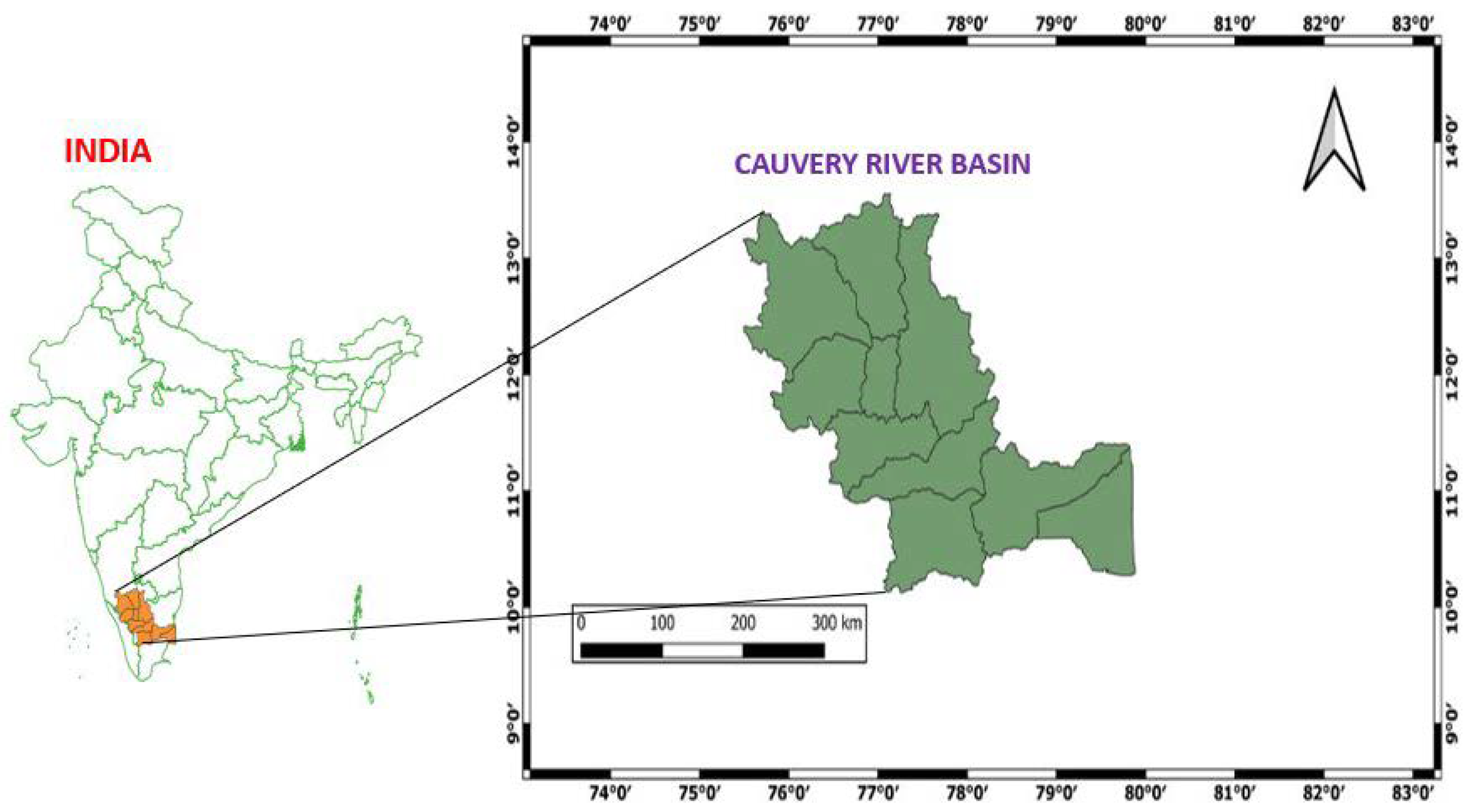


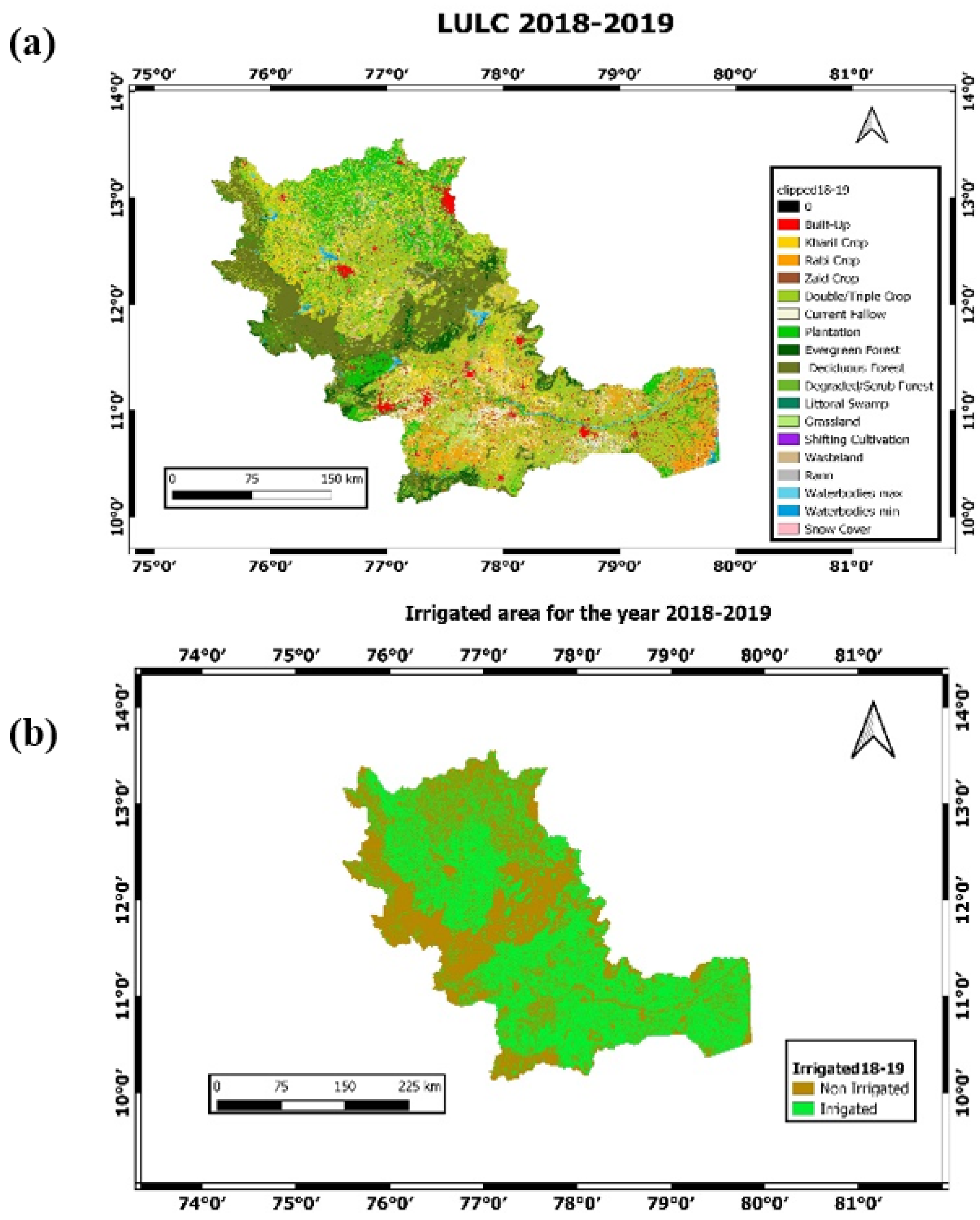
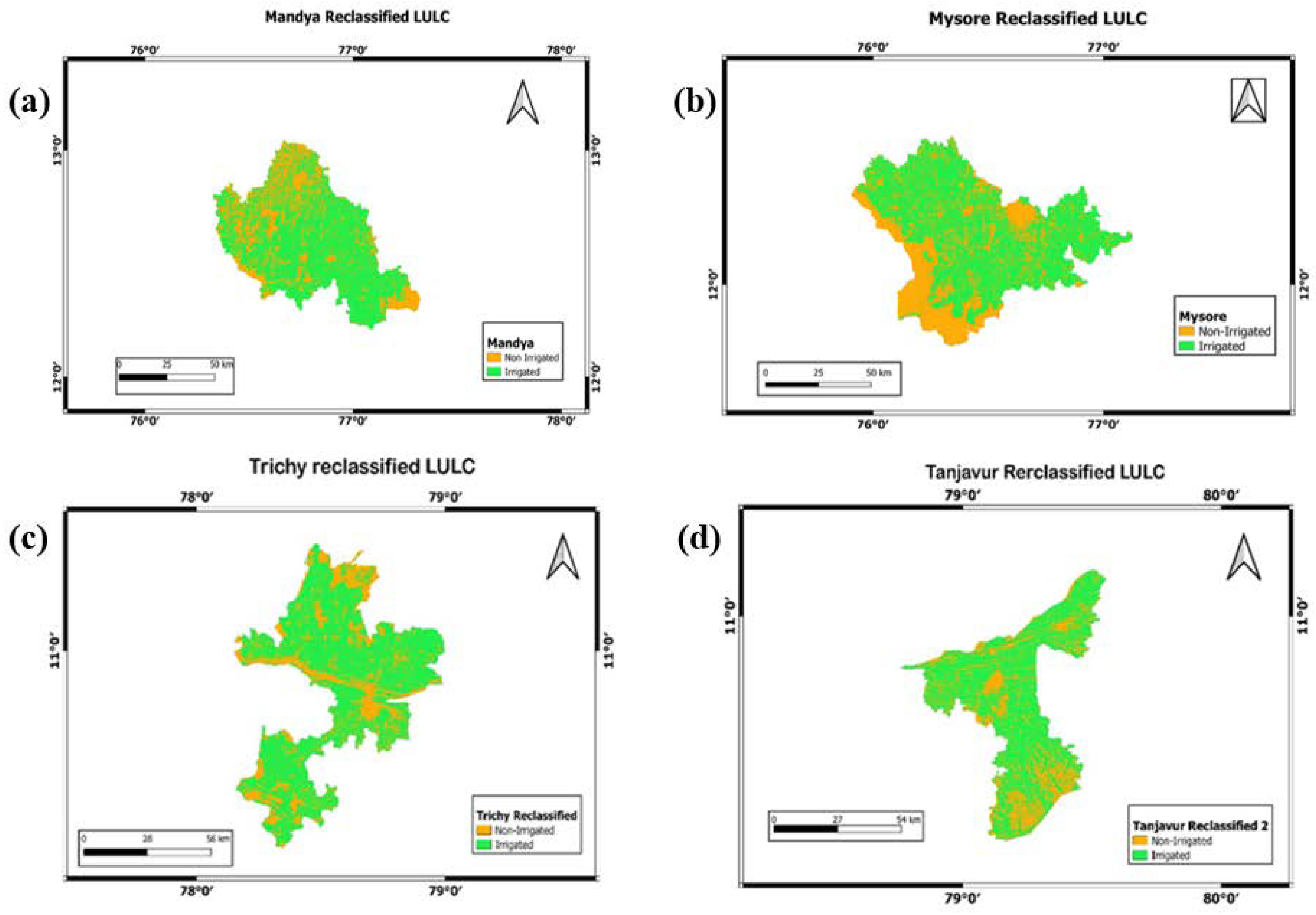
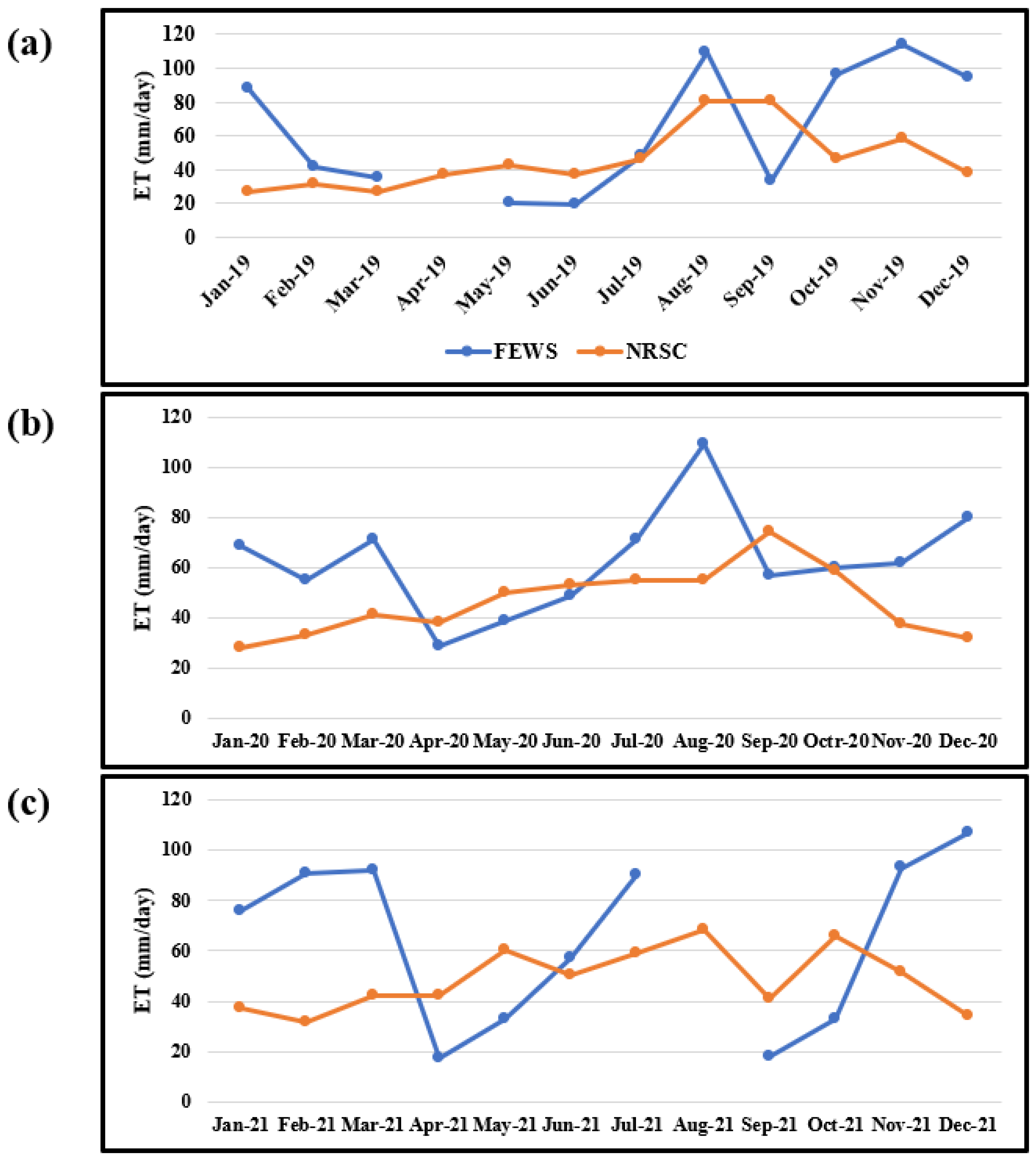
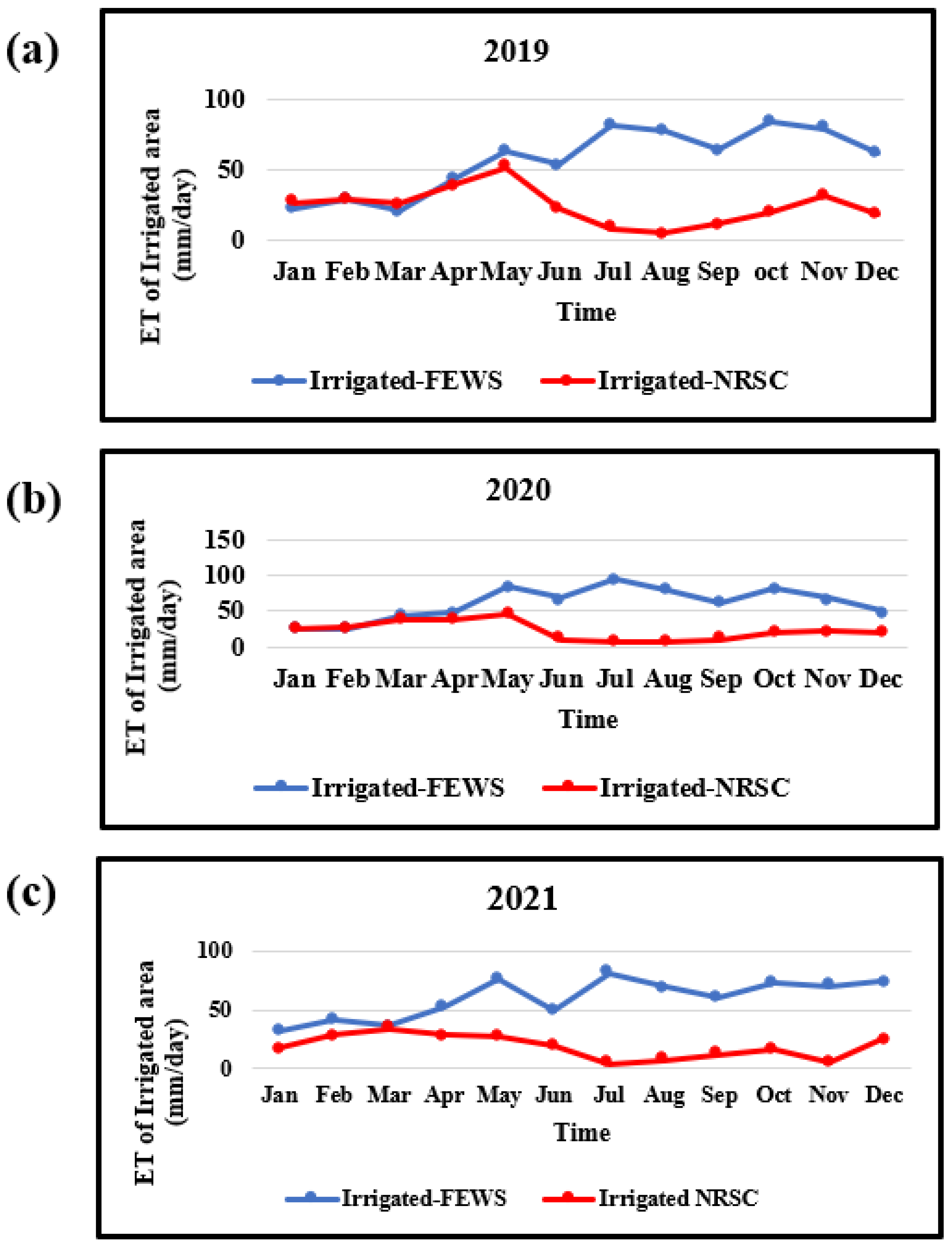

| Year | 2019 | 2020 | 2021 | |
|---|---|---|---|---|
| Month | ||||
| May | 2 | |||
| June | 4 | 4 | 9 | |
| July | 4 | 4 | 4 | |
| August | 1 | 4 | 3 | |
| September | 2 | 6 | 6 | |
| October | 5 | |||
| November | 1 | |||
| December | 6 | |||
| Year | Mean ETa of Mandya | Mean ETa of Mysore | Mean ETa of Tiruchirappalli | Mean ETa of Thanjavur |
|---|---|---|---|---|
| 2003 | 568.99 | 447.16 | 654.03 | 1005.89 |
| 2004 | 583.41 | 540.17 | 659.86 | 1148.15 |
| 2005 | 722.15 | 626.58 | 844.84 | 1278.94 |
| 2006 | 654.15 | 560.67 | 987.82 | 1246.25 |
| 2007 | 682.53 | 580.62 | 774.69 | 1270.30 |
| 2008 | 740.51 | 645.16 | 910.09 | 1239.63 |
| 2009 | 727.24 | 600.52 | 808.31 | 1236.40 |
| 2010 | 763.26 | 669.76 | 848.51 | 1251.02 |
| 2011 | 807.81 | 670.49 | 918.18 | 1239.86 |
| 2012 | 654.36 | 488.10 | 767.03 | 1098.95 |
| 2013 | 675.29 | 586.90 | 634.99 | 1132.22 |
| 2014 | 751.05 | 638.29 | 691.31 | 1158.62 |
| 2015 | 732.38 | 643.98 | 793.60 | 1137.50 |
| 2016 | 506.63 | 434.44 | 572.35 | 1094.25 |
| 2017 | 598.36 | 553.68 | 657.60 | 1159.60 |
| District | Mandya | Mysore | Trichy | Thanjavur |
|---|---|---|---|---|
| R2 (ETa vs. Crop Yield) | 34.04% | 19.27% | 25.58% | 12.36% |
| R2 (ET Anomaly vs. Crop Yield) | 55% | 41.8% | 30.21% | 35.17% |
Disclaimer/Publisher’s Note: The statements, opinions and data contained in all publications are solely those of the individual author(s) and contributor(s) and not of MDPI and/or the editor(s). MDPI and/or the editor(s) disclaim responsibility for any injury to people or property resulting from any ideas, methods, instructions or products referred to in the content. |
© 2024 by the authors. Licensee MDPI, Basel, Switzerland. This article is an open access article distributed under the terms and conditions of the Creative Commons Attribution (CC BY) license (https://creativecommons.org/licenses/by/4.0/).
Share and Cite
Anand, A.; Keesara, V.R.; Sridhar, V. Studying the Relationship between Satellite-Derived Evapotranspiration and Crop Yield: A Case Study of the Cauvery River Basin. AgriEngineering 2024, 6, 2640-2655. https://doi.org/10.3390/agriengineering6030154
Anand A, Keesara VR, Sridhar V. Studying the Relationship between Satellite-Derived Evapotranspiration and Crop Yield: A Case Study of the Cauvery River Basin. AgriEngineering. 2024; 6(3):2640-2655. https://doi.org/10.3390/agriengineering6030154
Chicago/Turabian StyleAnand, Anish, Venkata Reddy Keesara, and Venkataramana Sridhar. 2024. "Studying the Relationship between Satellite-Derived Evapotranspiration and Crop Yield: A Case Study of the Cauvery River Basin" AgriEngineering 6, no. 3: 2640-2655. https://doi.org/10.3390/agriengineering6030154
APA StyleAnand, A., Keesara, V. R., & Sridhar, V. (2024). Studying the Relationship between Satellite-Derived Evapotranspiration and Crop Yield: A Case Study of the Cauvery River Basin. AgriEngineering, 6(3), 2640-2655. https://doi.org/10.3390/agriengineering6030154









